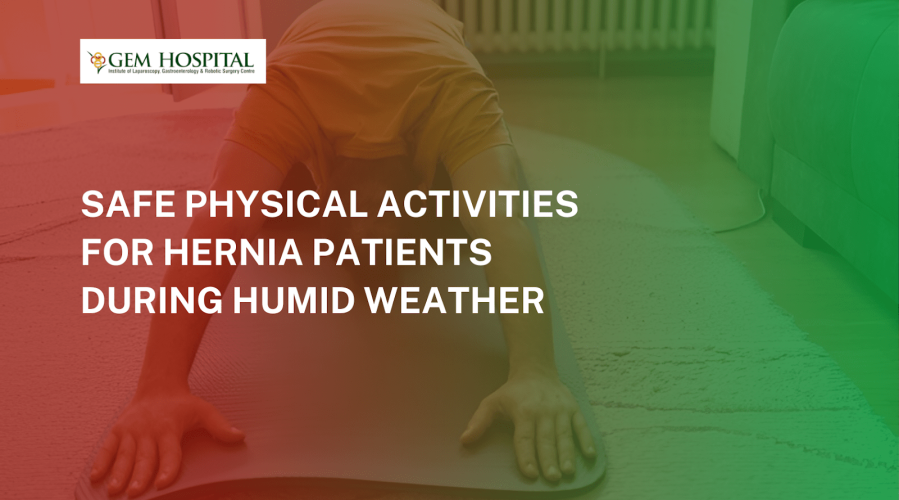Learn why street foods can increase the risk of esophageal and gastric issues. Understand contamination, hygiene lapses, and safety tips to protect your digestive health.
Safe Physical Activities for Hernia Patients During Humid Weather

When the weather becomes humid, even simple tasks can feel more laborious and for those with a hernia, this discomfort may become pronounced. Humidity causes the body to sweat more, which can lead to dehydration and exhaustion. When the weather is humid, patients with hernias need to be especially careful of the type and intensity of exercise that they are doing.
The good news is that exercising is not only possible but also is safe if done wisely and safely.
What is a Hernia and Safety of Exercise
A hernia forms when an internal organ pushes through a weak point in the surrounding muscle or tissue wall. The most common types of hernia are inguinal (groin), umbilical (navel), incisional (after surgery), and hiatal (upper stomach).
Surgery is typically the advised option for the long-term management of a hernia, however, regular low-intensity exercise may be favorable to strengthen the muscles prior to surgery and post-operative hernia surgeries when the muscles are healing. Nevertheless, physical exercise during the summer months when a heavy workout can raise pressure in the abdomen may be difficult for the hernia patient.
Why Does Humidity Matter
Humidity weighs down the air and adds resistance to the body cooling down through sweating. This causes:
- More fatigue
- Increased intra-abdominal pressure
- The risk of dehydration and feeling faint
For the hernia patient, all of these feelings can lead to increasing pain, swelling, or bulging sensations near the hernia. Therefore, it is necessary to keep your exercise plan flexible and change during humid conditions.
Safe Exercises for Patients with a Hernia
Here are exercises that are very soft on the abdomen but good for maintaining strength and mobility.
1.Walking
Walking is one of the safest, and importantly, one of the best forms of exercise for individuals with a hernia. Walking improves circulation, stimulates digestion, and helps to strengthen lower body musculature without stressing the abdomen.
Tip: Walk early in the morning or late in the evening when humidity is lower.
Duration: You can walk for 20–30 minutes per day at a comfortable pace.
2. Pelvic Tilts
Pelvic tilts are a great way to strengthen the lower abdominal and pelvic muscles to help relieve pressure at the site of a hernia.
How to perform pelvic tilts: Lying on your back with your knees bent and feet resting flat.
- Tighten your lower abdominal muscles and flatten your back against the floor.
- Hold flat for 5 seconds and relax.
- Repeat for a total of 10–12 repetitions.
Note: Avoid lifting your hips too high; keep it subtle!
3. Diaphragmatic Breathing (Deep Belly Breathing)
This exercise helps to control abdominal pressure and promotes relaxation.
How to diaphragmatic breath: while sitting or lying comfortably, and draw air deep into your belly through your nose, allowing your belly to rise. Exhale slowly through your mouth, and repeat for a total of 5–10 minutes.
Note: Practicing diaphragmatic breathing every day will improve oxygenation and reduce excessive strain on the internal muscles.
4. Gentle Stretching
Gentle stretching keeps the body flexible and may also improve posture which may help reduce hernia pressure indirectly.
Gentle stretches like shoulder rolls, neck stretches, and very mild side bend (NOTE: avoid twisting) are all okay to do for gentle rolling motions or stretching.
StretchLeg Raises (Modify)
If your doctor agrees, mild leg raises will help strengthen the lower abdominal and thigh muscles.
Modified version:
Keep one leg bent, and lift the other about a few inches off the floor; do not perform both legs together this increases abdominal pressure.
Stationary Cycling (Low Resistance)
This is a great indoor option (if your doctor clears you) for light cardio exercise during humid weather months when your cardiovascular fitness needs improvement. Stationary cycling will help with your stamina without directly stressing the abdomen.
Ensure you adjust the bike seat to a height you feel comfortable at and maintain an upright posture while keeping an appropriate amount of lean forward (you do not want excessive leaning forward).
Exercises to Avoid When It Is Humid
Certain movement patterns will be particularly irritating for a hernia when combined with the high humidity of summer, as it fatigues the body and creates increased abdominal pressure. Avoid:
- heavy weightlifting (squats and deadlifting especially);
- crunches, sit-ups, and planks;
- high-intensity interval training (HIIT);
- jumping, or any explosive movement;
- yoga poses (if they involve deep twisting and/or compression of the core).
Hydration and Cooling Tips
Just as choosing the proper exercise is important for your successful exercise plan, keeping hydrated is as important. Make sure to drink water pre-, during, and post-exercise, and- if needed- additional electrolyte intake.
Hydration
- You want to make sure to drink plenty of water pre, during, and after the workout.
- Wearing light, breathable clothing will help sweat (once you begin to perspire) evaporate.
- Exercise will be easier when you are in a cooler area such as the shaded part of the outside, or better yet, any air conditioning.
- In case you're sweating more than normal, sometime you can have a coconut water or any other sports drink that is heavy on electrolytes.
- Avoid exercising outside or anywhere outside of your air conditioning when the heat and humidity are at its highest between the hours of 10 AM and 4 PM.
Listening to Your Body
Pain, discomfort, or a sensation of pulling around the hernia, are signs to stop volunteering this activity, and even if you are doing a light exercise, measure if it is truly light for you, if there are any measures of strain then it has not been a light exercise. Always progress in a slow and measured manner, and always consult with your physician or physiotherapist prior to initiating any new exercise plan, and after any of your surgical procedures.
Lifestyle Add-Ons for Patients With A Hernia
- Outside of exercise, you should develop supportive habits during the humid months.
- Maintaining a healthy body mass is helpful to relieve some of the sheer pressure of lift on to the abdominal walls.
- Eating fibers to assuage any strain of possible constipation, as this causes undue straining.
- Avoiding smoking, and/or having any chronic coughing spells, as this creates higher likelihood that a hernia will demonstrate symptoms, or worsen potential symptoms.
- Be mindful of your poise, posture, and/or how straight you stand when you sit or stand, as slouching or bending forward increases the pressure on the belly.
In the end, exercising safely with a hernia during humid or just-hot weather, is a balance of being aware of your body. Choose lighter movement protocols that are lower impact (i.e walking, doing breath work, and some light stretches) to stay active without heavy exertion. Make sure to remain hydrated, monitor how hard you get, and always clear exercise with your physician before making changes to your current plans, especially if you are recently post-surgery or whenever you have a new exercise introduced into your day.
If you have any pain, swelling, or discomfort during exercise, immediacy of care is to pursue medical direction.
For expert medical management of your hernia symptoms, contact GEM Hospital—a leading center for hernia care and hernia-specific minimally invasive procedures today.
Book your appointment at GEM Hospital today for next steps toward a safer recovery and a healthier you.
Blogs & Article
Learn how to protect your colon during the monsoon by avoiding contaminated food and water. Get essential hygiene, diet, and safety tips to prevent infections.
Discover how poor monsoon hygiene increases gut infections, weakens digestion, and leads to long-term health risks. Learn prevention tips for a healthier monsoon.


